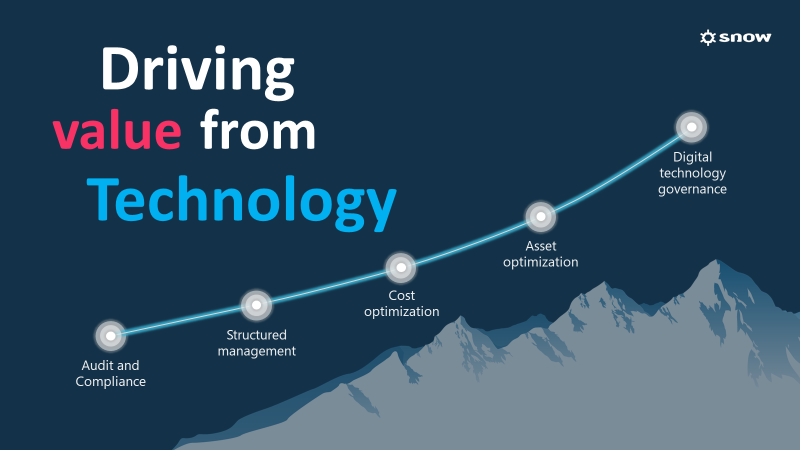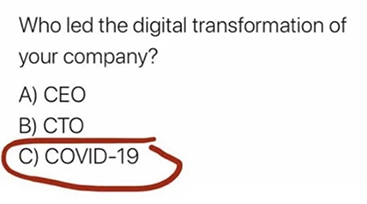A Perspective on the IT and Human Impacts of our Current Reality

I’ve just been listening to a webinar about cost optimization which raised a number of interesting points. Amongst other things they talked about the impact on IT budgets. The average IT budget is being cut by 10-20% despite the need for additional spending to support remote working and increased resilience. However, it was highlighted that budgets for digital transformation are being protected, as organisations are clear that this is the way forward, and the current crisis has highlighted this.
In this situation, IT organisations are trying to identify and cut waste and discretionary spending, as well as understand the real business value of their technology investments. They need not just to survive the economic uncertainty ahead, but also protect their workforce from unemployment. As one general manager I spoke to this week told me ‘My business is dependent on the people – I need to find ways to retain them. If I have to let them go now and then later recruit people to replace them, I lose skills and experience and incur both redundancy and recruitment costs’. Technology isn’t about replacing people with robots – it’s about helping people work more effectively.

(Source: The Rise of the Digital Native – ‘Generation S’ and their impact on you.)
When we’ve talked about the evolution of IT Asset Management (ITAM) over the last couple of years we discussed the move from cost optimisation and driving more value from technology to using technology intelligence to
“Provide a better understanding of the interaction between people and technology, and this is what helps us to drive value not only from the technology but also from people – freeing them from repetitive and unproductive work and allowing them to add value through creativity and flexibility that machines alone can’t achieve.” – (Source: The Rise of the Digital Native – ‘Generation S’ and their impact on you.)
This sits at the heart of our view of human-centred IT.
What’s happening in the world of technology right now?
The first thing I want to say is that no one can predict what’s going to happen. Despite all the ‘back to normal’ and ‘new normal’ talk, no one really knows what the implications of this virus are for our economies, political systems, societies and businesses. I saw a tweet the other day saying something like ‘Suddenly everyone is a futurist now that we don’t know what the future looks like’. Most individuals and organisations aren’t looking much more than 6 weeks ahead. There may be generic planning going on beyond that but right now even 6 weeks feels like a long time given how much uncertainty there is and how much has changed from week to week.
What we have seen:
- Millions of people out of work either temporarily (furloughed) or permanently (made redundant)
- Millions of people working remotely at very short notice
- Businesses changing the way they work and the way they deliver products and services. In some cases even changing the products and services they deliver
What we do know is likely to happen at some undefined point in the future:
- Some people will go back to work – some to the same jobs, some to different jobs
- Some people will go back to the office – but anyone who CAN work from home will probably need to justify going into an office. And anyone who has even a hint of sickness will be expected to stay at home
- Some businesses will go back to the old way of delivery
- Some businesses will go back to the old products and services that can’t be delivered remotely or digitally
- Some businesses will go back to the old way of working – some will find their new ways are better.
You’ve probably all seen this:

What does this mean for businesses?
Who will be working?
Despite furlough schemes in many countries, we’ve seen global increases in unemployment, and it is inevitable that this will continue. There will be lots of people out there looking for jobs, some of whom will need to develop new skills. But overall, this also means that for those businesses that are recruiting there will be a bigger pool of skilled workers to choose from. Salaries may drop, and if the cost of labour in home markets reduces, we may see work that is currently outsourced or offshored moved back onshore.
Where will they be working?
It’s worth remembering that not everyone can work remotely. While it is relatively straightforward for office workers (even some call centres have been changed to 100% remote), there are many roles where this isn’t possible. However, more remote employees mean fewer people in the office, and with the need for social and physical distancing, the way we use offices will change. We’re expecting to see additional investment in Integrated Workspace Management Systems to allow workplaces to be managed more effectively for the lower numbers of people that will be using them, and also to ensure that capacity limits (which were previously based on fire regulations and will now be based on distancing and ventilation needs) aren’t breached. Salesforce recently introduced work.com to help organisations manage a return to the workplace where continued remote working isn’t feasible.
Remote working will continue to be the norm for most office workers rather than an exception (for example, many of the big tech companies have already said that they expect people to work from home for the rest of the year, and Twitter has said that employees who want to continue to work from home forever will be able to) and while there are lots of different estimates out there as to the percentage of employees that will work from home in future, what is clear is that office/knowledge workers are likely to be spending at least some proportion of their working week based at home.
What technology will they be using?
Technology spending forecasts have changed dramatically over the last few months, and Gartner now forecasts that global IT spending will be down 8% from 2019 to 2020. However, they expect cloud spend to increase by around 10%, in part sustained by the need to support the rapid changes organisations have made, and to provide ease of access to remote workers. The moves to the cloud forced by remote working will remain and force digital transformation and migration of legacy systems.
In addition, we’ve also seen changes in retail spending on technology as people purchase equipment to allow them to work from home while homeschooling their kids. NPD US retail tracking for w/c 25th April showed:
- PCs – week-on-week increase to 62% from 53%
- Printers – week-on-week increase 54% from 36%
- Mesh routers – week-on-week 60% for 6th consecutive week
- Range extenders (183%), monitors (78%), Headphones (39%), tablets and accessories (71% revenue increase)
More remote working means there is a need for investment in collaboration software and unified communications systems. Some of the products that were deployed rapidly to fill gaps in capability (such as Zoom) may remain, or they may be replaced as organisations go through their usual technology selection processes to find long-term solutions. The need to focus on resilience highlighted by the response to the pandemic means organisations will be considering redundancy (if one service is down, can we use another?) and the need for multi-vendor and multi-cloud strategies. There is also a clear need to invest in addressing neglected infrastructure and consider either migration of legacy systems or improved remote access where that isn’t possible.
What are their priorities?
Let’s think back to the example at the beginning of this post. Cost cutting is clearly a priority. But not indiscriminate cost-cutting. There are tough decisions to be made, and organisations will be informed by their objectives, ethics and finances. Many people are hoping that the crisis we’ve been through (and are still enduring) will result in a more ethical, kinder and less aggressive world. Not everyone is convinced. But whatever is driving the business response to the pandemic, the current economic situation and the unknown impact on society and behaviour of the ongoing health crisis – as well as the expected continued economic downturn – means most organisations are looking at how they will survive. They’re also considering what they have learned.
Organisational priorities have changed, and just as I looked in a previous post at individual priorities changing to focus on survival, the same is true of many businesses. To do this, they need visibility and information to allow them to make decisions at speed. The world has become unpredictable, no one is doing any real long-term planning. As our CFO James Denena said in his blog post, even our company is looking at different scenarios so that we can respond appropriately to circumstances as they unfold.
What does this mean for the future?
The move to the cloud is accelerating, as is the move to the edge, both driven in part by remote working and in part by changes in the way businesses serve their customers. The recent launch of the Starlink satellites and the rapid growth in 5G deployments are very timely developments and indicate that the move to remote working can be sustained and improved as they support the move of workloads to the edge. These technologies are crucial to the growth of edge technologies and will accelerate automation via IoT devices and the use of AR and VR technologies for remote operation of equipment or improved collaboration experiences.
How can I get involved and help address these challenges?
As we continue to move through this period of uncertainty, if you have a perspective or a story to share, please don’t hesitate to reach out and start a dialogue. I will continue to review the ripple effects of the changing developments and offer analysis both here and on LinkedIn.